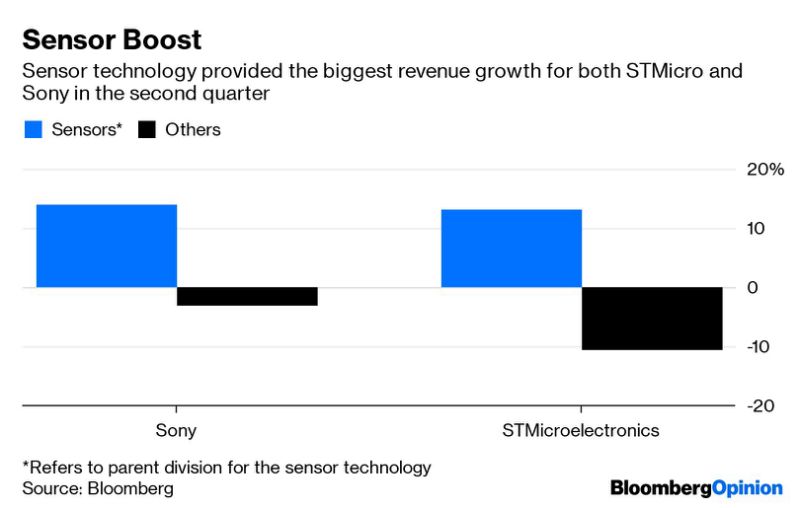(Bloomberg Opinion) — Smartphone sales may be stagnating, but one particular strand of technological wizardry behind them is not. Companies that make the sensors powering your phone’s camera and facial recognition system are preparing for a mini boom.
The slowdown in global smartphone sales has made life tougher for semiconductor makers. Chips giants from Qualcomm Inc. to Samsung Electronics Co. Ltd. have all recently issued disappointing forecasts. Pricing for memory chips is close to an all-time low.
One bright spot is the market for 3-D and camera sensors. Smartphone makers are either struggling to find major new innovations, or are holding them back for handsets that are 5G-enabled and can transmit heaps of data very quickly. Meantime, the likes of Apple Inc. and Huawei Technologies Co. Ltd are pushing more incremental design improvements: Bigger displays and better cameras. The displays often require more sensors too, as fingerprint scanners make way for optical sensing systems.
That’s good news for the likes of Sony Corp., Infineon Technologies AG, STMicroelectronics NV and AMS AG. All have intimated that the technology is finally gaining some traction, two years after the iPhone X first brought 3-D sensors to a mass market smartphone with Face ID.
Both Sony’s and ST Micro’s sensor arms were their fastest growing business in the most recent quarter as they ramped up production for the arrival of new smartphones in the third quarter. AMS bucked the trend of recent years to forecast growth for the rest of the year that exceeds expectations.
This new upswell has as much to do with photography as facial recognition. Even as handset sales drop, more advanced and therefore higher margin image sensors are going into the handsets that are still sold.
Huawei and Apple have made photography a selling point. The Chinese firm’s P30 Pro is marketed with the tagline “Rewrite the Rules of Photography” and comprises five different cameras, including a front-facing one.
That’s boosted demand for both image sensors and 3-D sensors, which are used to improve the focus and depth perception on the back-facing cameras, as well as for facial recognition on the front. Apple’s next top-of-the-range iPhone will include three rear-facing cameras when released later this year, Bloomberg News has reported.
Alphabet Inc.’s Google will also release an updated Pixel smartphone that comprises an innovative 3-D motion sensor array that lets users control the handset without touching the screen. Much of the underlying hardware will be supplied by Infineon.
It’s a promise that is overdue. AMS had anticipated a far faster return on its significant investment in the technology. It mistimed its spending and the stock has suffered as a consequence. Infineon, Sony and STMicro have invested in a steadier fashion and benefit from the deep pockets that their other businesses afford them.
One reason for the recent uptick in adoption is the arrival of a new class of “time-of-flight” sensors. The iPhone’s Face ID relies on a more complex system known as “structured light.” Not only have Apple’s supplier exclusivity agreements made it harder for rivals to imitate its approach, but the technology’s complexity makes it trickier and more expensive to implement.
Time-of-flight gear works the way it sounds, by measuring how long it takes for a laser signal to bounce off an object and inferring its topography accordingly. It requires fewer components and is generally more robust, reducing the risk of breakage and therefore wastage in the manufacturing process.
STMicro has a close working relationship with Apple, so may benefit most from the next iPhone. Sony works with the Cupertino, California-based firm too, but has also benefited from the rise of Huawei’s smartphone business. Google’s smartphone business remains small, limiting the upside for Infineon, but its handsets become design standards for others that run on the search giant’s Android operating system. That positions Infineon well for further design wins.
Usually, new technology gets industrial applications before filtering down to consumers. When it comes to 3-D sensors, it’s the reverse. Companies such as STMicro and Infineon are building relationships with suppliers that will continue when the sensors go into factories in a few years’ time. Yet more devices will go into cars, monitoring driver behavior and attention. Things are looking up.
To contact the author of this story: Alex Webb at [email protected]
To contact the editor responsible for this story: Stephanie Baker at [email protected]
This column does not necessarily reflect the opinion of the editorial board or Bloomberg LP and its owners.
Alex Webb is a Bloomberg Opinion columnist covering Europe’s technology, media and communications industries. He previously covered Apple and other technology companies for Bloomberg News in San Francisco.
<p class="canvas-atom canvas-text Mb(1.0em) Mb(0)–sm Mt(0.8em)–sm" type="text" content="For more articles like this, please visit us at bloomberg.com/opinion” data-reactid=”62″>For more articles like this, please visit us at bloomberg.com/opinion
©2019 Bloomberg L.P.








